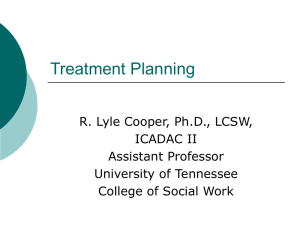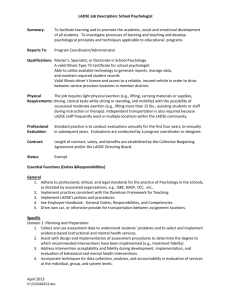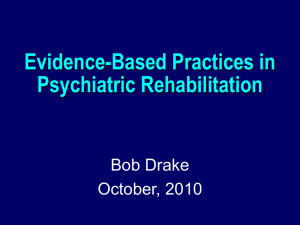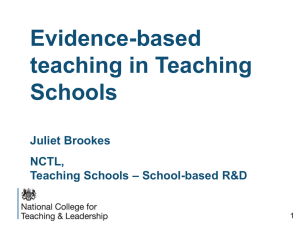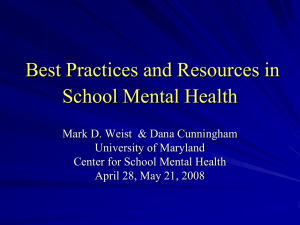school mental health
advertisement
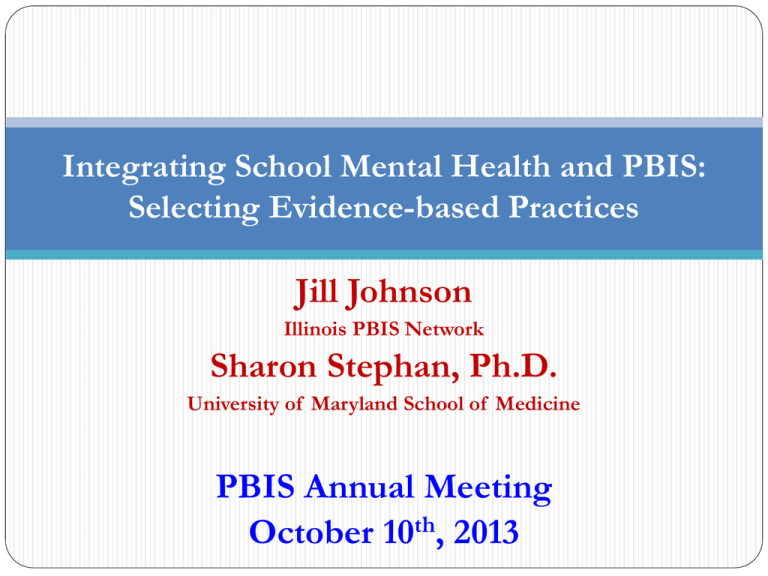
Integrating School Mental Health and PBIS: Selecting Evidence-based Practices Jill Johnson Illinois PBIS Network Sharon Stephan, Ph.D. University of Maryland School of Medicine PBIS Annual Meeting October 10th, 2013 Objectives 1. Describe at least two strategies for integrating PBIS and school mental health. 2. Name at least one evidence-based mental health practice at each level of the public health triangle. 3. Describe the difference between evidence-based manualized and modularized mental health interventions. Center for School Mental Health MISSION To strengthen the policies and programs in school mental health to improve learning and promote success for America’s youth • Established in 1995. Federal funding from the Health Resources and services Administration. • Focus on advancing school mental health policy, research, practice, and training. • Shared family-schools-community agenda. • Co-Directors: Sharon Stephan, Ph.D. & Nancy Lever, Ph.D. http://csmh.umaryland.edu, (410) 706-0980 Our Team SCHOOL MENTAL HEALTH – A DEFINITION A partnership between schools and community health organizations… Guided by youth and families. Builds on existing school programs, services, and strategies. Focuses on all students… …in both general and special education Includes a full array of programs, services, and strategies Definition of school mental health •Involves partnership between schools and community health/mental health organizations, as guided by families and youth •Builds on existing school programs, services, and strategies •Focuses on all students, both general and special education •Involves a full array of programs, services, and strategies- mental health education and promotion through intensive intervention (Weist & Paternite, 2006) Who provides mental health services in schools? Research Supported Interventions Involve…. • • • • • • Strong training Fidelity monitoring Ongoing technical assistance and coaching Administrative support Incentives Intangibles Practice in the Trenches? • Involves NONE of these supports What’s happening on the “front lines”? “Some Good Stuff” • Increasing emphasis on: – Evidence-based (research-supported) Practice (EBP) – Outcomes – Consideration of cultural context in development, implementation and evaluation of EBP – Recognition of the importance of meaningfully partnering with families – Increased emphasis on workforce development of mental health providers and educators “Some Not-So-Good Stuff” • Limited control/accountability of providers and services provided • Gaps in training, particularly related to schools and evidencebased practice • “C.O.W. Therapy” – Crisis of the Week Challenges selecting evidencebased MH practices • School/clinician has not: – assessed specific needs of school/students – identified target outcomes – defined “success” (of interventions) – identified a way to measure intervention fidelity • MH interventions are often not designed for complex issues Activity Think of a current intervention that your district/school/organization uses to address student needs. Answer the following questions regarding said intervention: • Selection of the intervention allows for clear and measureable outcomes YES NO • The intervention provides for generalization YES NO • The implementation of the EBP allows for the assessment of implementation fidelity YES NO Consumer Guide to Selecting Evidenced Based Mental Health Services Main Components • Assessment • Interventions Selection • Intervention Progress Monitoring Assessment Intervention Selection Intervention Progress Monitoring Potential Uses of the Tool • To determine needs of a school/agency/community • To determine what EBP may be most effective to address needs • To guide the implementation of an EBP • To reflect on current EBP – Celebrate that components are in place – Action plan on how to include necessary components Who Can Utilize the Tool • • • • Building or District-level teams Community-level teams Joint building or district-community teams Practitioners Illinois Example Reflecting on Current Evidence-based Practices • District Leadership Team had a concern that interventions utilized by staff were not culturally relevant nor appropriate to address needs – Wanted a non-confrontation way for social workers to reflect on their practices, lack there-of • Tool was used at a School Social Work meeting within the district School Social Work Meeting Results Mean = 6 Social Worker Responses to Assessment 120% 100% Percentage 80% 60% Social Worker Response 40% 20% 0% Assessment of need/risk Assessment strengths/deficits Appropriate team Assessment Questions Appropriate sb intervention Referral to mh professional Social Worker Response Intervention Selection 120 100 Percentage 80 60 40 20 Social Worker Response 0 Assessment Questions Social Worker Response Intervention Progress Monitoring 90 80 70 Percentage 60 50 40 Social Worker Response 30 20 10 0 MH Intervention implementation fidelity Ongoing data-based progress monitor Progress Monitoring Questions Report/Review progress at team District Leader Thoughts • Partnership between school and community providers is lacking • Implementation fidelity not addressed • Progress monitoring interventions not done systematically • Self-assessment by social workers may not be accurate – Budget issues – Defensive • Example: They scored themselves 100% on culturally relevant interventions: however, students on intervention were all AfricanAmerican and at-risk for change of placement District Action Steps • Work towards school-community partnership on Strategic Plan/District Leadership Team – Short-term goal: Quarterly, one community partner invited to school social work meeting • Long-term goal: add community partners back on DLT • Long-term goal: each building collaborate with one community partner; add to tiered team • Add implementation fidelity and evaluation tools to practice – Short term goal: Strickland tools • Offer professional development/support for social workers – Short-term goal: Use Consumer Guide, BAT, ISSET to drive school social work meetings monthly CURRENT TRENDS AND FUTURE DIRECTIONS IN SMH Four Themes in Quality Services • Systematic Quality Assessment and Improvement • Family Engagement and Empowerment • Modular, Evidence-Based Skill Training • Implementation Support Quality Assessment and Improvement (QAI) Principles • Emphasize access • Tailor to local needs and strengths • Emphasize quality and empirical support • Active involvement of diverse stakeholders • Full continuum from promotion to treatment • Committed and energetic staff • Developmental and cultural competence • Coordinated in the school and connected in the community Examples of QAI tools • School Mental Health Quality Assessment Questionnaire (SMH-QAQ) – https://csmh.umaryland.edu • Mental Health Planning and Assessment Template (MHPET) – www.nasbhc.org Effectively Partnering with Families • Early focus on engagement, e.g., through candid discussions about past experiences • Emphasize empowerment and the potential for improvement • Provide pragmatic support • Emphasize mutual collaboration • See McKay, Hoagwood Results of using these elements 120 100 80 60 40 100 88 85 76 64 52 40 20 0 Accepted 1st Appt. 2nd Appt. 3rd Appt. % for first interview (n=33) % for comparison (n=74) Focus on Evidence-Based Practice – “Manualized” and “Modularized” Intervention/Indicated: Cognitive Behavioral Intervention for Trauma in Schools, Coping Cat, Trauma Focused CBT, Interpersonal Therapy for Adolescents (IPT-A) Prevention/Selected: Coping Power, FRIENDS for Youth/Teens, The Incredible Years, Second Step, SEFEL and DECA Strategies and Tools, Strengthening Families Coping Resources Workshops Promotion/Universal: Good Behavior Game, PATHS to PAX, Positive Behavior Interventions and Support, Social and Emotional Foundations of Early Learning (SEFEL), Olweus Bullying Prevention, Toward No Tobacco Use Modularized Interventions – aka “Common Elements” approaches • Chorpita, B.F., & Daleiden, E.L. (2007). 2007 Biennial Report: Effective Psychosocial Intervention for Youth with Behavioral and Emotional Needs. Child and Mental Health Division, Hawaii Department of Health – (Reviews most important treatment foci for Anxiety, Attention Problems, Autism, Depression, Disruptive Behavior Disorders, Substance Use, and Traumatic Stress) Origins of the “Common Elements” Approach Step 3: Step 1: Emphasis on evidenced-based treatments Step 2: Development of treatment manuals Information overload: Too many treatment manuals to learn and manuals change as new knowledge is gained 39 How will I ever master all these treatment manuals ??? Illustration of Common Elements terminology Treatment Family Treatment Protocols Practice Elements From Chorpita & Marder, 2009. UCLA Common Elements Summer Social Work Workshop PracticeWise Resources • www.practicewise.com • Subscription-based resources: – PracticeWise Evidence-Based Services Database (PWEBS) – PracticeWise Practitioner Guides – PracticeWise Clinical Dashboards – Modular Approach to Therapy for Children (MATCH) Example of printable PDF describing practice element: Audience Goals of this practice element Steps for using this practice element Clinical Dashboards • Microsoft Excel based monitoring tool – Tracks achievement of treatment goals or other progress measures on a weekly/session basis – Documents which practice elements were used when • Dashboard can be customized: – Display up to 5 progress measures; – Write-in additional practice elements • Potential uses: – Documenting session activities – Tracking client progress – Clinical supervision Document which practice element was used when 48 Implementation Support • • • Focus on “indigenous” school resources Moving beyond “Train and Hope” Focus on: – Interactive and lively teaching – Off and on-site coaching, performance assessment and feedback, emotional and administrative support – Peer to peer support – User friendliness • see Dean Fixsen, Karen Blasé, National Implementation Research Network (NIRN) SCHOOL MENTAL HEALTH RESOURCES… National Community of Practice on School Behavioral Health www.sharedwork.org • CSMH and IDEA Partnership 12 practice groups: – Connecting School Mental Health and Positive Behavior Supports – Connecting School Mental Health with Juvenile Justice and Dropout Prevention – Education: An Essential Component of Systems of Care – Families in Partnership with Schools and Communities – Improving School Mental Health for Youth with Disabilities – Learning the Language: Promoting Effective Ways for interdisciplinary Collaboration – Psychiatry and Schools – Quality and Evidence-Based Practice – School Mental Health and Culturally Diverse Youth – School Mental Health for Military Families – Social, Emotional, and Mental Health in Schools – Youth Involvement and Leadership CSMH Annual Conference on Advancing School Mental Health • • • • • • • • 1996 Baltimore • 2005 Cleveland 1997 New Orleans • 2006 Baltimore 1998 Virginia Beach • 2007 Orlando 1999 Denver • 2008 Phoenix 2000 Atlanta • 2009 Minneapolis 2002 Philadelphia • 2010 Albuquerque 2003 Portland, OR • 2011 Charleston, SC • 2012 Salt Lake City, UT 2004 Dallas* * Launch of National Community of Practice on School Behavioral Health Mark your calendars for Oct 3-5, 2013 in Crystal CityArlington, Virginia JOURNALS School Mental Health • A Multidisciplinary Research and Practice Journal • Editor-in-Chief: Steven W. Evans Advances in School Mental Health Promotion • International efforts in SMH research, practice, policy and training • Editor-in-Chief: Mark Weist • Deputy Editor: Sharon Stephan (Editorin-Chief, as of January 2014) Sharon Stephan, Ph.D. sstephan@psych.umaryland.edu 410-706-0941 Center for School Mental Health University of Maryland, Baltimore School of Medicine Division of Child and Adolescent Psychiatry 737 W. Lombard St. 4th floor Baltimore, Maryland 21201 (http://csmh.umaryland.edu Email: csmh@psych.umaryland.edu Phone: (410) 706-0980 Nicole Evangelista, Ph.D. nevangel@psych.umaryland.edu


